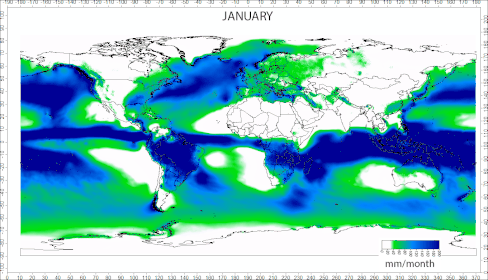THE PARTICULATE MATTER & PRECIPITATION

Precipitation
-
Precipitation in meteorology refers to all forms of liquid or solid water particles that form in the atmosphere and then fall to the earth's surface. Types of precipitation include hail, sleet, snow, rain, and drizzle. Frost and dew are not classified as precipitation because they form directly on solid surfaces.

Long-term mean precipitation by month
-
Formation
Clouds are the source of precipitation—the process that provides the fresh water essential for most forms of terrestrial life. Precipitation can form in two ways. In warm clouds, fine water droplets condense, collide, and coalesce into larger and larger droplets that can fall as rain. In colder clouds, ice crystals form and grow in a cloud that contains a mixture of both ice crystals and water droplets.
The first process occurs when saturated air rises rapidly and cooling forces additional condensation, as shown in Figure 4.16. For raindrops in a warm cloud, the updraft of rising air first lifts tiny suspended cloud droplets upward. By collisions with other droplets, some grow in volume. These larger droplets collide with other small droplets and continue to grow. Note that a droplet is kept aloft by the force of the updraft on its surface, and as the volume of each droplet increases, so does its weight. Eventually, the downward gravitational force on the drop exceeds the upward force, and the drop begins to fall. Now moving in the opposite direction to the fine cloud droplets, the drop sweeps them up and continues to grow. Collisions with smaller droplets can also split drops, creating more drops that can continue to grow in volume. Eventually, the drop falls out of the cloud, cutting off its source of growth. On its way to the Earth, it may suffer evaporation and decrease in size or even disappear.


Within cool clouds, snow is formed in a different way, known as the Bergeron process (Figure 4.17). Cool clouds are a mixture of ice crystals and supercooled water droplets. The ice crystals take up water vapor and grow by deposition. At the same time, the supercooled water droplets lose water vapor by evaporation and shrink. In addition, when an ice crystal collides with a droplet of supercooled water, it freezes the droplet. The ice crystals then coalesce to form ice particles, which can become heavy enough to fall from the cloud.

